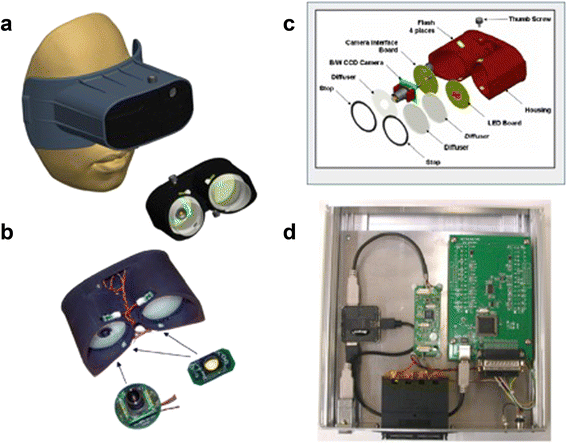A novel device for assessing dark adaptation in field settings
- PMID: 26156587
- PMCID: PMC4496941
- DOI: 10.1186/s12886-015-0062-7
A novel device for assessing dark adaptation in field settings
Abstract
Background: Aberrant dark adaptation is common to many ocular diseases and pathophysiological conditions, including vitamin A deficiency, cardiopulmonary diseases, and hypoxia. Scotopic vision and pupillary responsiveness have typically been measured using subjective, time-consuming methods. Existing techniques are particularly challenging for use in developing country settings, where vitamin A deficiency remains a major public health problem. Our aim was design a compact, low cost, and easily operated device to assess dark adaptation in the field.
Methods: The Portable Field Dark Adaptometer (PFDA) incorporates a digital camera, a retinal bleaching flash, and a Ganzfeld light source inside a pair of light-obscuring goggles. After a ~10 min period of dark adaption, the infrared camera digitally records afferent pupillary responses to graded light stimuli (-2.9 to 0.1 log cd/m(2)). We tested this device in a variety of field settings to assess: a) ease of use and b) whether test data could clearly and accurately depict the well-known dose-response relationship between light intensity and pupil contraction. A total of 822 videos were collected. We used an open source video analysis software to measure pupil size in pixel units. Pupillary responsiveness was expressed as the percent change in pupil size from pre- to post-light exposure. Box plots, t test, and multi-level mixed effects linear regression modeling were used to characterize the relationship between light intensity and pupillary response.
Results: The PFDA was employed with only minor technical challenges in Bangladesh, Kenya, Zambia, and Peru. Our data show a clear linear increase in pupillary constriction with increasing log light intensity. Light intensity was a strong predictor of pupillary response, regardless of baseline pupil size.
Conclusions: The consistent physiological response demonstrated here supports the use of the PFDA as a reliable tool to measure dark adaptation. As a next step, PFDA measurements will be validated against biochemical indicators of vitamin A status and hypoxemia. Ultimately, this new technology may provide a novel approach for nutritional assessment, with potential clinical applications.
Figures




References
-
- Working Group on Night Vision. Night Vision: Current Research and Future Directions, Symposium Proceedings. Washington, D.C.: National Academies Press; 1987.
-
- Havelius U, Hansen F, Hindfelt B, Krakau T. Human ocular vasodynamic changes in light and darkness. Invest Ophthalmol Vis Sci. 1999;40(8):1850–1855. - PubMed
Publication types
MeSH terms
Grants and funding
LinkOut - more resources
Full Text Sources
Other Literature Sources
Medical
Research Materials

